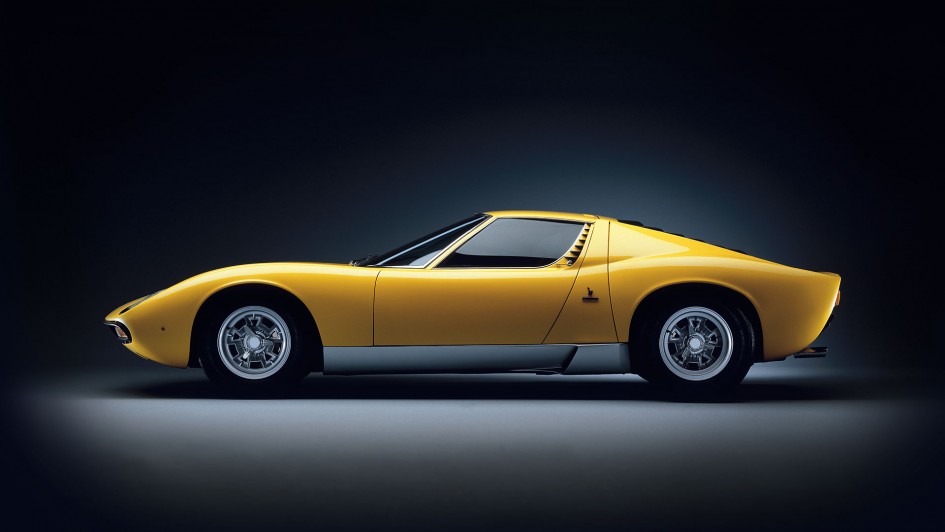Partager la publication "Lamborghini Miura : première supercar au moteur Posteriore 4 litri. V12. 350 ch. Genève 1966"
Miura est une des premières voitures de série dotées d’un moteur en position centrale arrière. La Miura a été présenté par Bertone pour Lamborghini, au salon de Genève en mars 1966. Mais à l’origine un prototype, au nom de code TP400, a fait sensation au salon de l’automobile de Turin en 1965.
Miura
Miura est un élevage, ganadería de toros de lidia, fondée en 1842 par Juan Miura par un croisement de vaches Gil de Herrera et de José Luis Alvareda, toutes d’origine Gallardo, établies sur les terre de El Puerto de Santa María. L’élevage est basé à la finca Zahariche, sur le territoire de la commune de La Campana, près de Séville.
À l’origine l’élevage Miura est aussi un encaste qui comprend quatre branches majeures : Juan Miura, issu de Gallardo et Gil Herrera, Juan Miura, issu de Cabrera, Jeronimo Núñez de Prado, Eduardo miura, issu de Vásquez, Duque de Osuna-Veragua, et Antonio et José Miura, issu de Vistahermosa, Murube, Parladé.
Les taureaux de cette ganadería sont généralement considérés comme les plus dangereux, les plus fougueux et les plus combatifs et très braves (ils sont aussi des animaux traditionnellement très hauts sur pattes ce qui en fait des adversaires difficiles à maîtriser). Cette ganadería s’honore d’avoir donné le plus grand nombre de taureaux graciés pour leur combativité.
Le châssis de la Lamborghini Miura
En 1965, Lamborghini trois ingénieurs, Gian Paolo Dallara, Paolo Stanzani, et Bob Wallace mettent leur propre temps dans le développement d’un prototype de voiture au nom de code P400. Les ingénieurs ont imaginé un véhicule qui pourrait gagner sur la piste et circuler sur la route. Les trois hommes ont travaillé sur la conception, la nuit, dans l’espoir de convaincre Lamborghini un tel véhicule ne serait ni trop cher, sans distraire l’orientation de l’entreprise.
Le châssis TP400, abréviation de « Trasversale Posteriore 4 litri » avait été construit à partir de tôle d’acier qui avait été plié, coupé, soudé et percé dans un style plus propre à l’aéronautique qu’à l’automobile. Une innovation radicale comparée à la solution usuelle des châssis tubulaires de section circulaire ou ovale. Un travail d’orfèvre réalisé par l’ingénieur Gian Palo Dallara.
La structure de la Lamborghini TP 400 se compose d’une plate-forme en acier sur laquelle sont soudés des caissons et deux berceaux (avant et arrière), l’ensemble étant allégé par de multiples perforations.
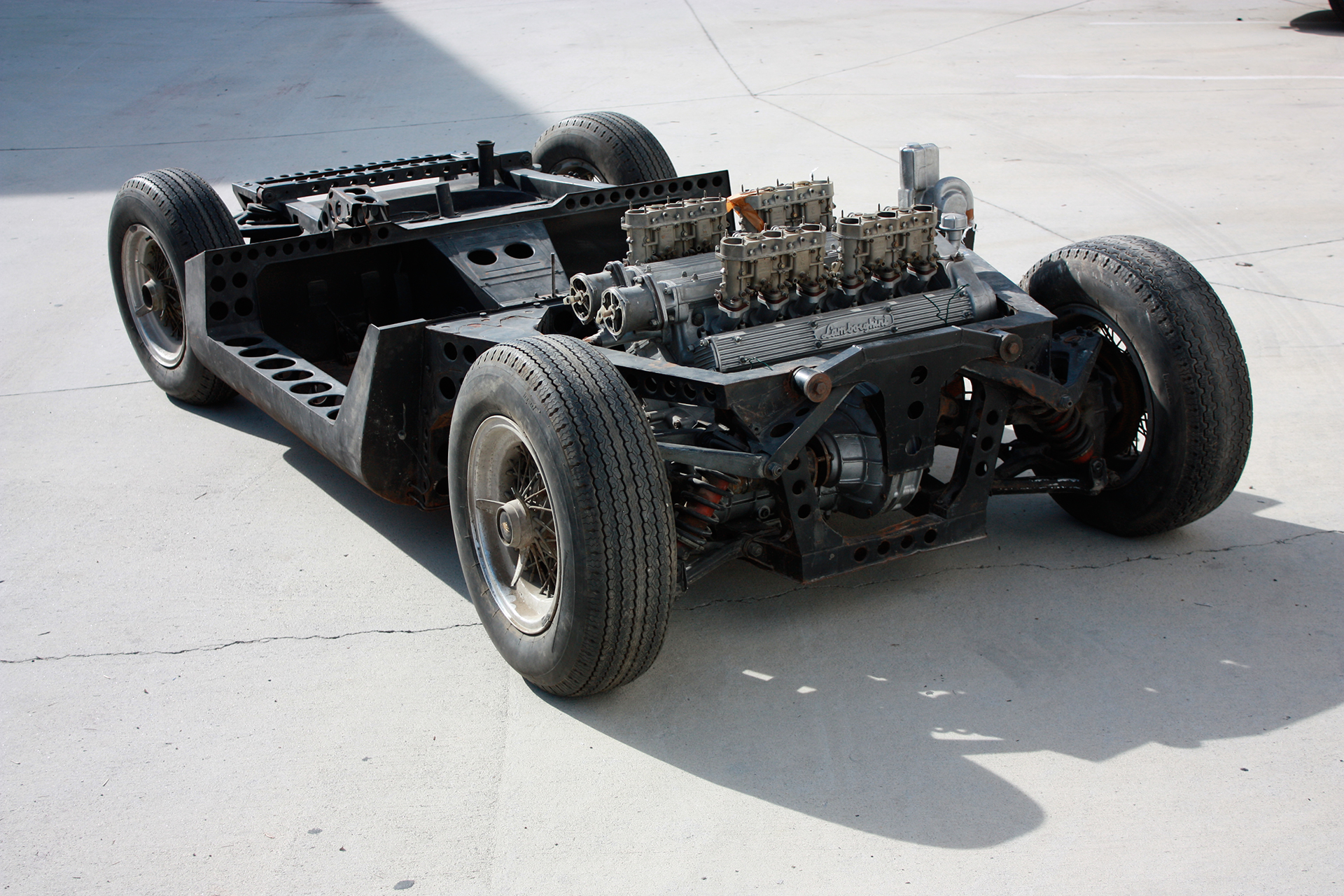
Lamborghini P400 – châssis moteur / chassis engine
Les roues de 15 pouces chaussées de pneus à flancs hauts paraissent en revanche bien minces en comparaison du potentiel mécanique… D’autant plus que la Miura est légère, comme une authentique voiture de course, elle pèse moins d’une tonne, 980 kg précisément.
Le châssis eut un succès phénoménal au Salon de l’auto de Turin. L’intérêt manifesté par tous les grands du design et maison du style automobile, tous intéressés par la perspective de dessiner une carrosserie pour ce nouveau châssis sensationnel, donna lieu à une série d’entrevues privées avec Ferruccio Lamborghini.
Nuccio Bertone, il carrozziere torinese era uno che di automobili e di motori se ne intendeva, e molto: non appena ebbe visto il telaio andò da Ferrucio Lamborghini e gli disse « io sono quello che può fare la scarpa per il tuo piede ». Si strinsero la mano e iniziò così un’avventura straordinaria.
Quelques semaines plus tard, en février 1966, Bertone pouvait annoncer officiellement avoir été engagé par Lamborghini pour créer la carrosserie du nouveau châssis. Le designer en chef de la maison de Turin, Marcello Gandini, avait en fait déjà commencé à travailler sur le projet dès la fermeture du Salon de Turin, fin 1965.
Le moteur de la Lamborghini Miura
Le moteur est conçu par Giotto Bizzarini, chez Automobili Lamborghini S.p.A. depuis 1963. Le bloc comporte douze cylindres en V, deux doubles arbres à cames en tête. L’ensemble est alimenté par quatre carburateurs Weber double corps. Cubant 3929 cm³, il fournit 350 chevaux à 7000 tr/min sur les premières versions.
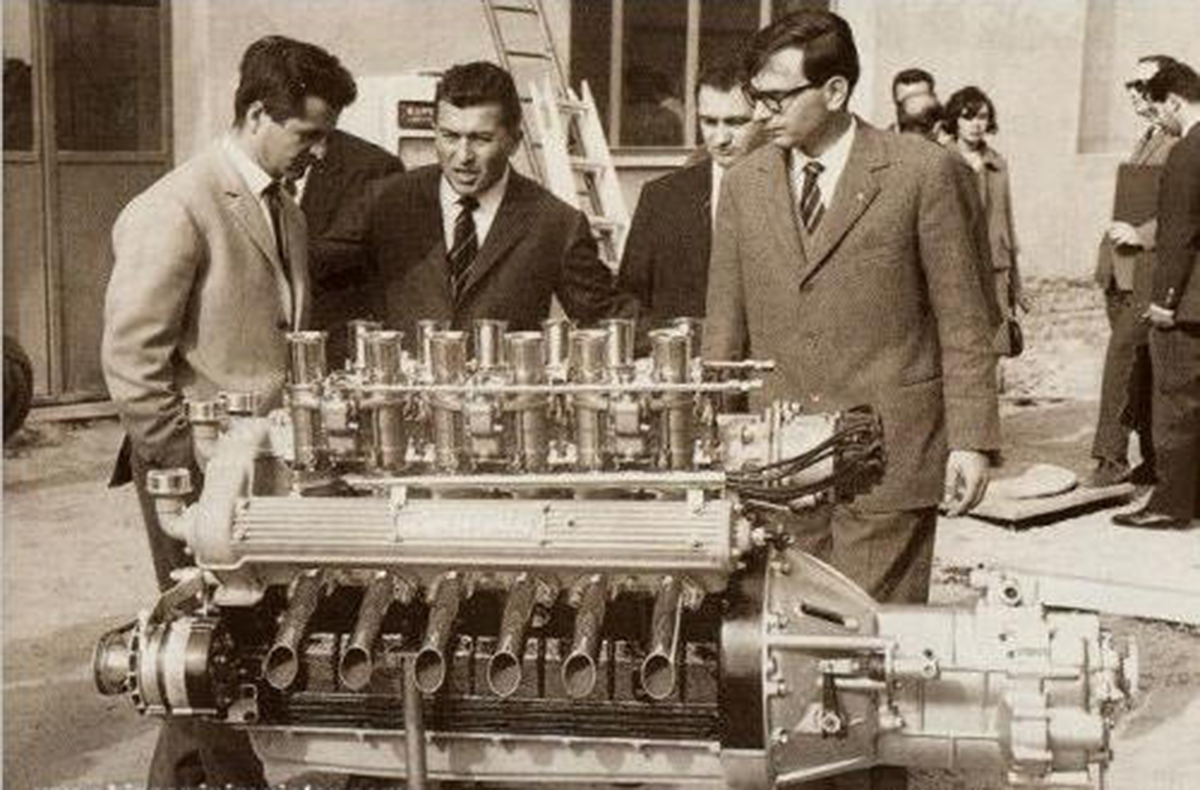
V12 – Giotto Bizzarini – Ferruccio Lamborghini – Gianpaolo Dallara
Le moteur, 12 cylindres en V de 3,9 litres de cylindrée, développe 350 ch. Cela a donné naissance à un bloc d’un nouveau type, où l’on incorpora l’embrayage, la transmission et le différentiel. Grâce à cette sculpture singulière en alliage léger, les ingénieurs ont pu incorporer les pièces mécaniques principales du TP400 dans une structure unique, légère, résistante et compacte. En plaçant le moteur directement derrière le cockpit et devant le train arrière, et donc au niveau du centre de gravité de la voiture, la répartition du poids et le moment d’inertie polaire apparaissent donc particulièrement avantageux.
Entièrement réalisé en alu, le moteur et ses organes revendiquent 270 kg. Le bloc est conçu pour ne faire qu’une pièce puisque même l’embrayage, la boîte et le différentiel y sont accolés. Cloisonné, il est lubrifié par un carter sec tandis que son aptitude aux hauts régimes vient en partie du volant moteur réduit, permis par les pignons d’entraînement de boîte et l’embrayage.
La révolution majeure est la position centrale arrière, en transversal et non plus en longitudinal, du V12 tandis que les arbres à came et les carburateurs étaient logés à la verticale.
Le design de la Lamborghini Miura
Marcello Gandini, qui avait rencontré Nuccio Bertone est recruté et remplace Giorgetto Giugiaro, au poste de responsable du style chez Bertone. Son employeur l’invite à concevoir des projets pour le prochain Salon de Genève, qui se tient dans quatre mois. C’est dans ce laps de temps très court qu’il imagine la carrosserie de Lamborghini P400.
Le dessin est de Marcello Gandini, qui a alors 27 ans, ingénieur designer automobile chez Bertone. La Miura est sculpturale, dessinée avec une folle audace et démode instantanément toutes les autres GT alors disponibles sur le marché.
Le design extérieur de la Lamborghini Miura
Le dessin de Gandini est le fruit d’une étude analytique effectuée en soufflerie. Cette recherche a permis d’obtenir à des résultats très affinés en matière d’aérodynamisme. Le résultat est un coupé deux places très bas, aux lignes affûtées et totalement nouvelles. Son profil et ses phares ronds l’a rend unique et reconnaissable.
Gandini proposa trois couleurs spécifiques : l’orange, un vert pomme et un jaune, inédit.
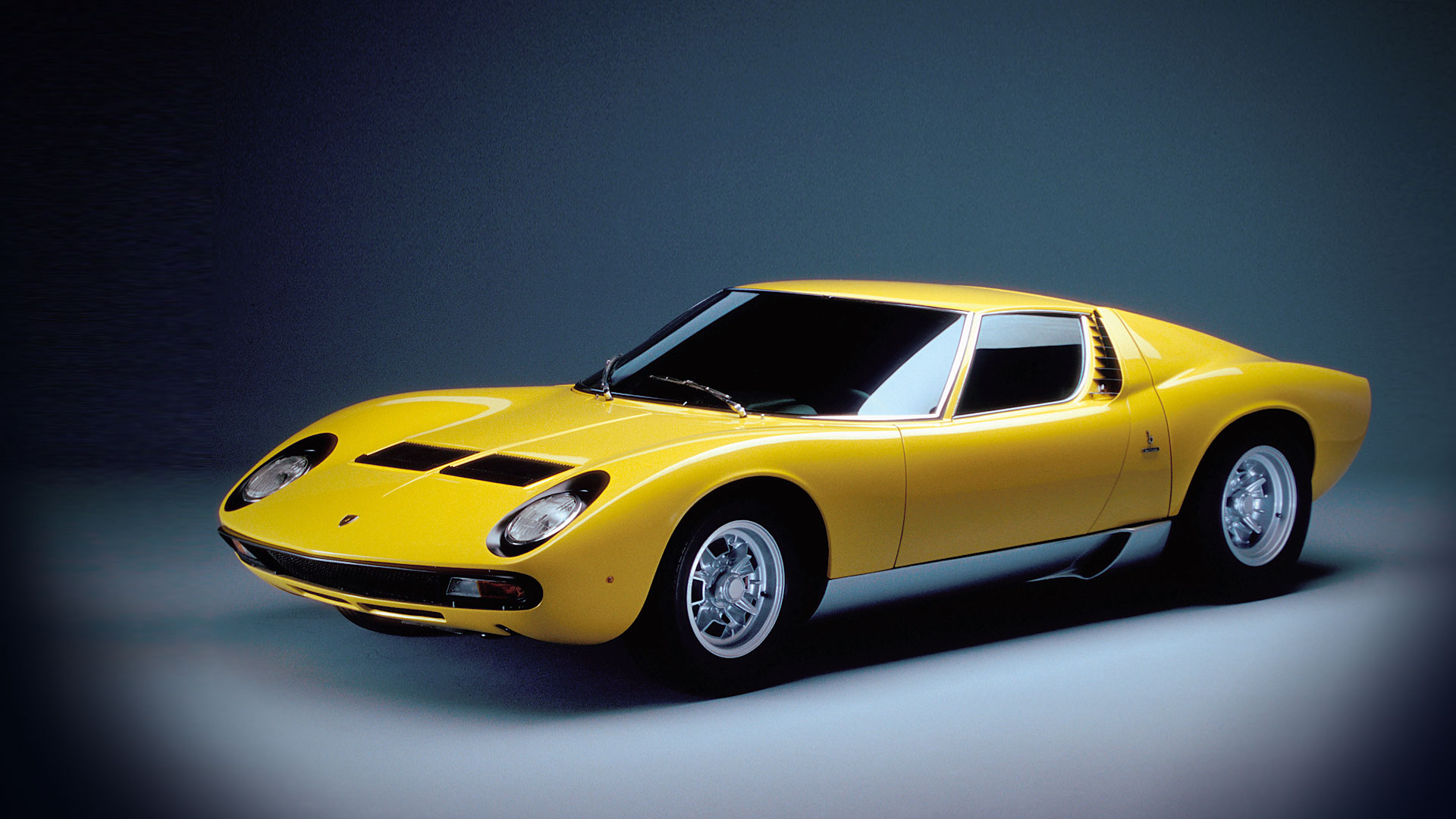
Lamborghini Miura – profil avant / front side-face
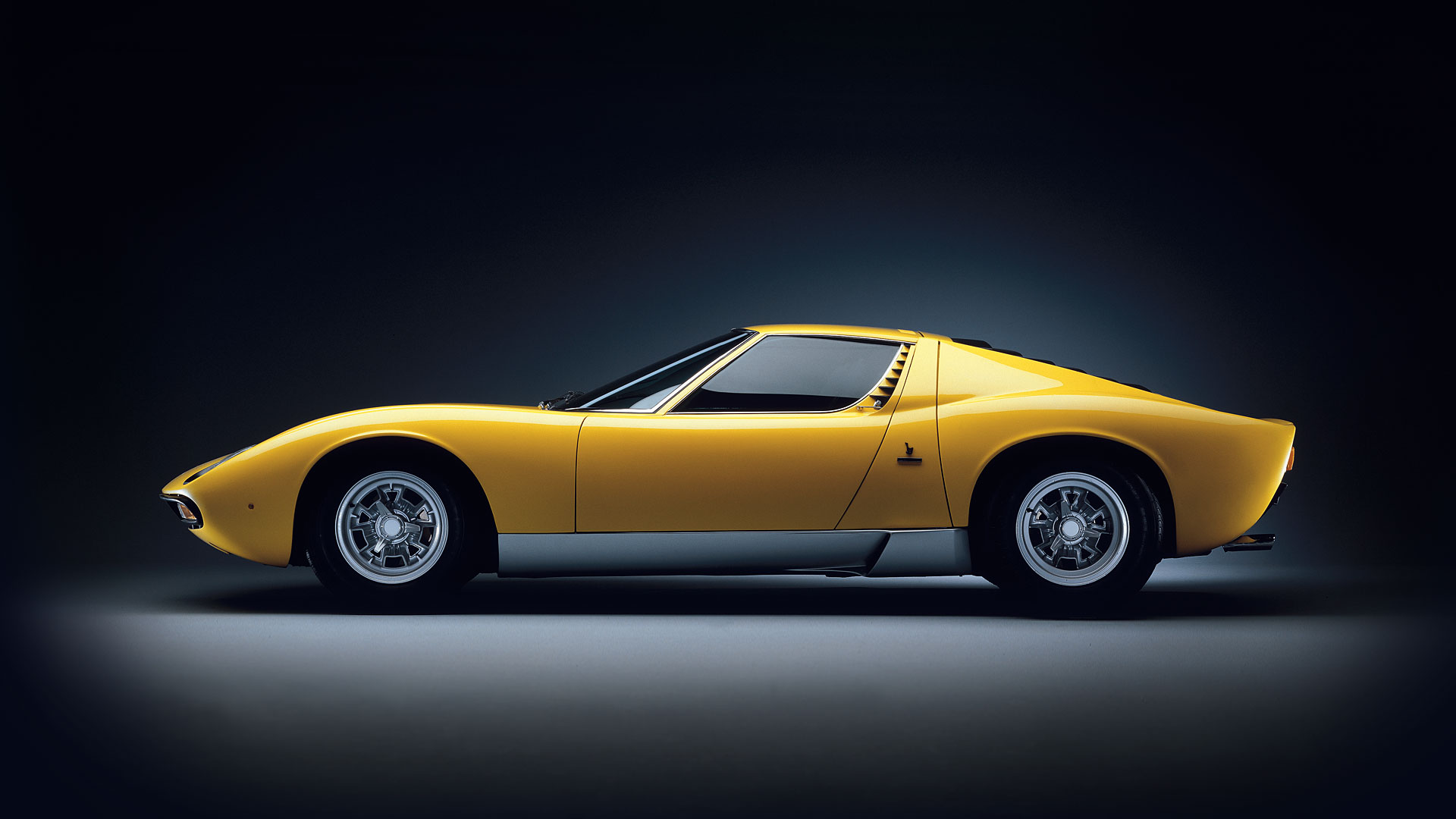
Lamborghini Miura – profil / side-face
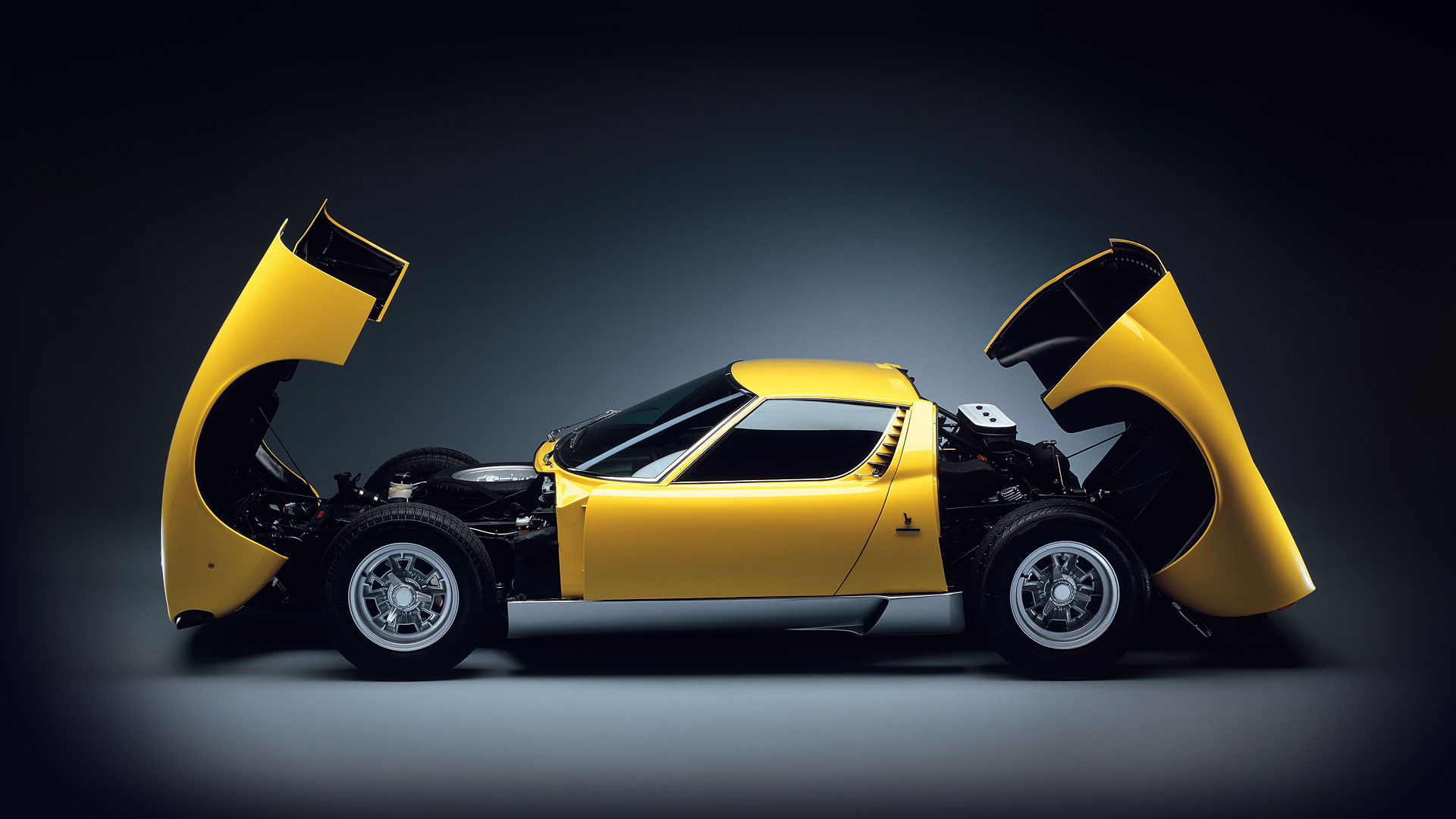
Lamborghini Miura – profil – capot ouvert / side-face – open
La carrosserie est constituée de trois partie distinctes : l’avant, le cockpit et l’arrière, démontables séparément les unes des autres pour faciliter l’accès au moteur et autres éléments mécaniques.
Les dimensions de la P400 son parfaitement équilibrées. L’empattement de 2,50 m pour une longueur totale de 4,36 m limite le porte-à-faux avant et arrière. La largeur de 1,76 m n’est pas impressionnante mais avec des voies AV/AR de 1,41 m et surtout une hauteur de 1,05 m seulement, la supercar est posée si près du sol et semble ne faire qu’un avec la route.
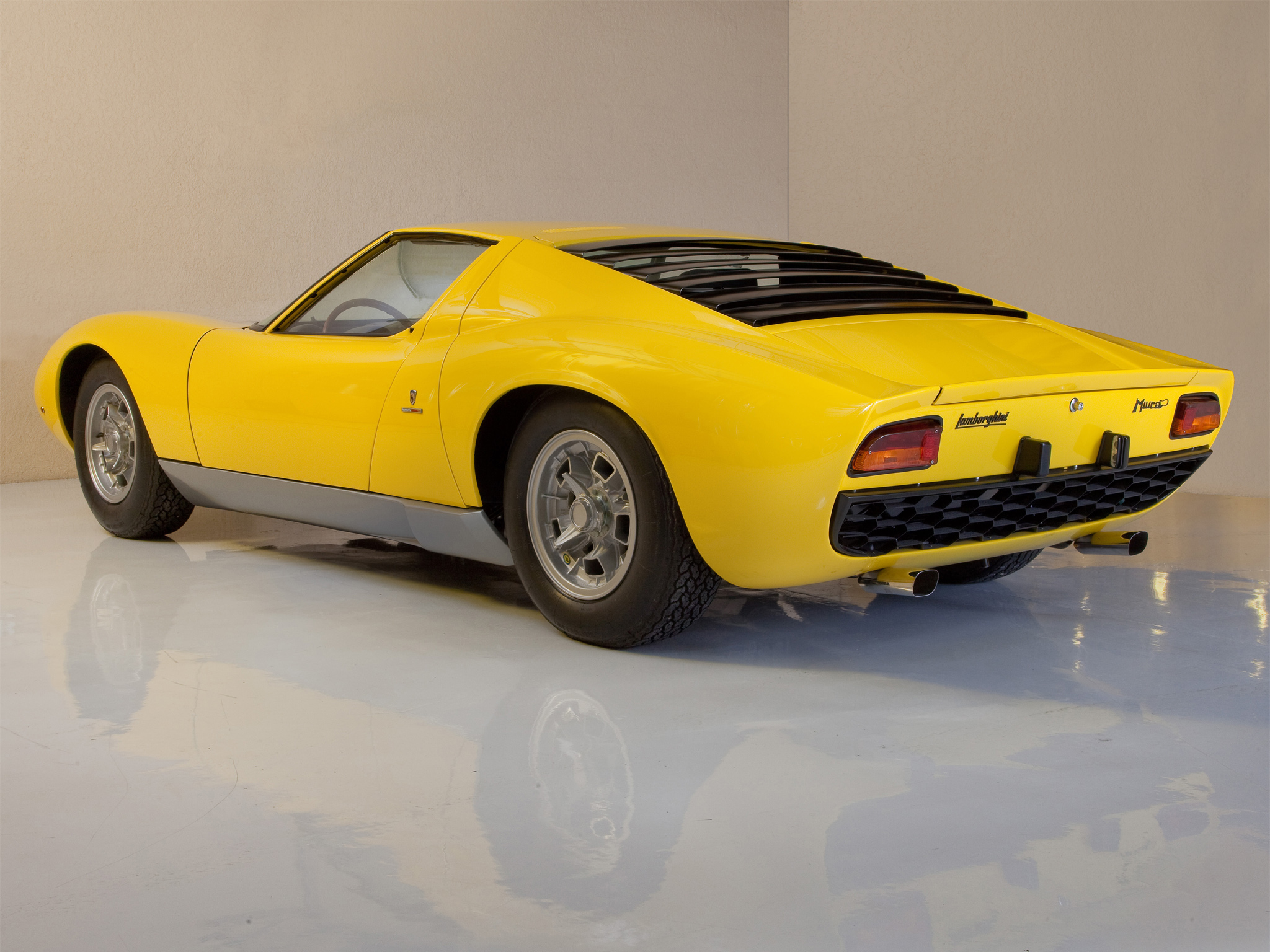
Lamborghini Miura – profil arrière / rear side-face
Le design intérieur de la Lamborghini Miura
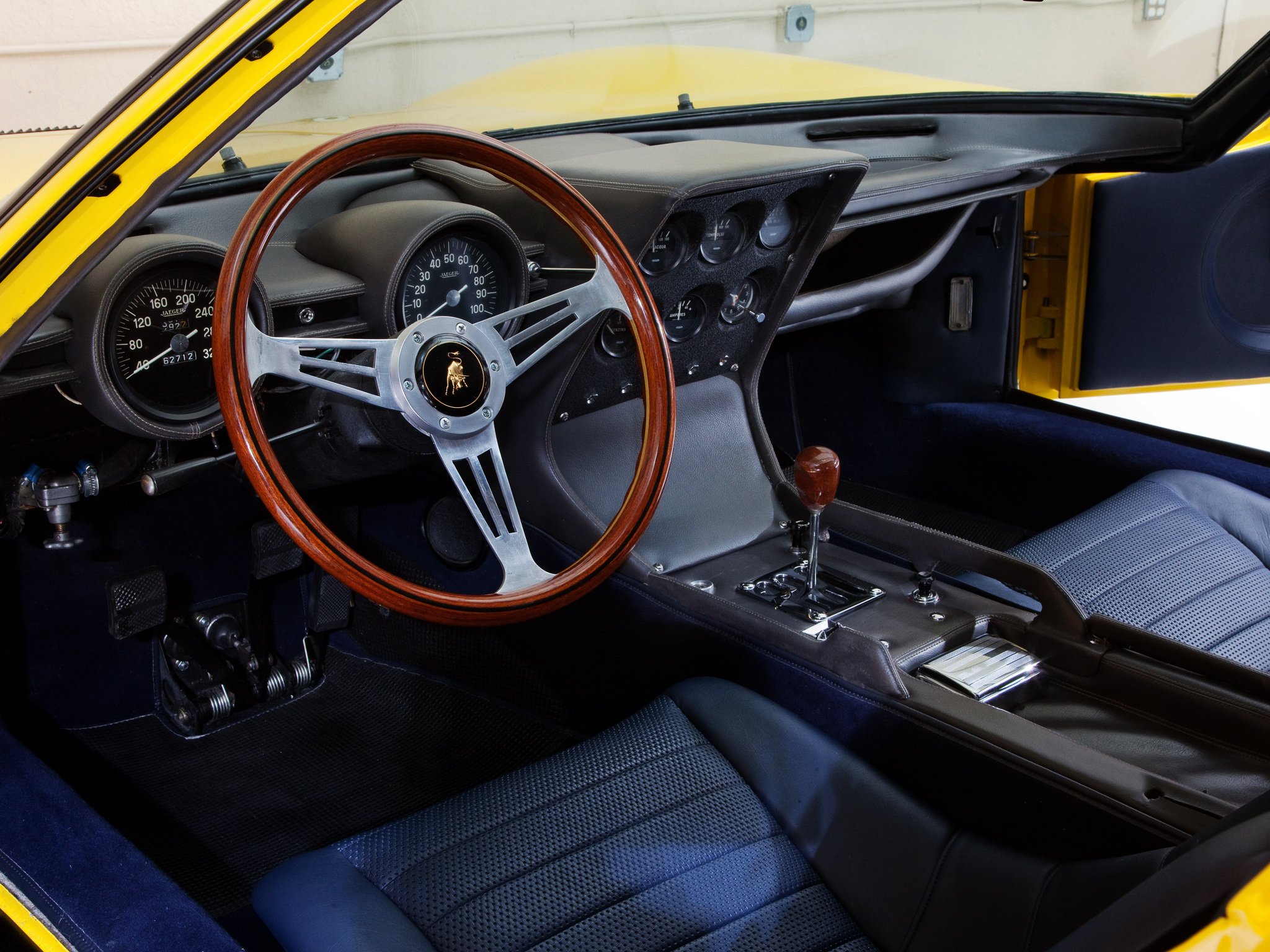
Lamborghini Miura – intérieur / interior
Lamborghini P400 Miura – Genève 1966
Le premier prototype, P400 pour Posteriore 4 litri, fut présenté sur le stand de Bertone au salon de Genève, le 10 mars 1966. Le prototype peint en orange, est personnellement conduit par Bertone au Salon de Genève. La Miura régnait au Salon de l’automobile de Genève.
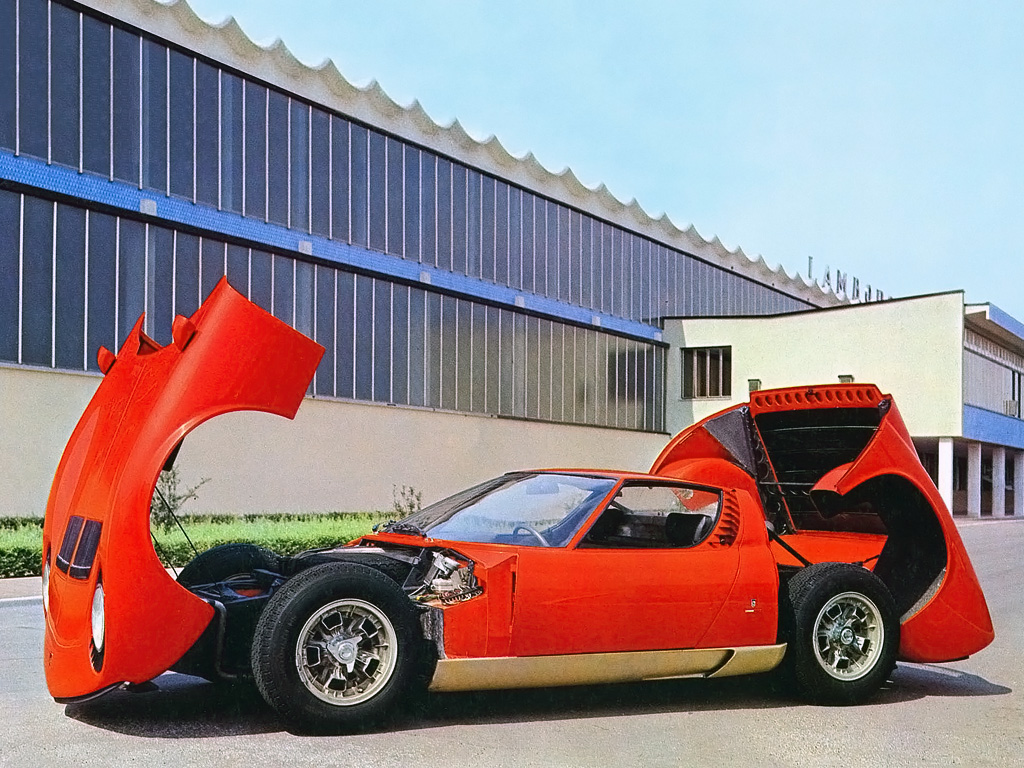
Lamborghini P400
La réaction favorable à Genève signifiait que la P400 était à entrer en production l’année suivante. En quittant l’usine, les quelques automobiles ont été équipés de pneus Pirelli Cinturato 205VR15 tyres (CN72).
Ferruccio Lamborghini, né signe Taureau, a choisi le nom d’un célèbre élevage de taureaux des plus dangereux, des plus fougueux et des plus combatifs et très braves, Miura.
1966 Lamborghini Miura – 50° Anniversario
L’année 2016 marque le 50ème anniversaire de la Lamborghini Miura. Reconnue comme la première supercar au monde, et toujours reconnue comme une des plus belle automobile.
L’exposition 2016 exposition Concept Cars, au Festival Automobile International, met à l’honneur l’un des plus grands designers automobile du XXème siècle, Marcello Gandini designer chez Bertone, le créateur de la Miura de 1965 pour Lamborghini.
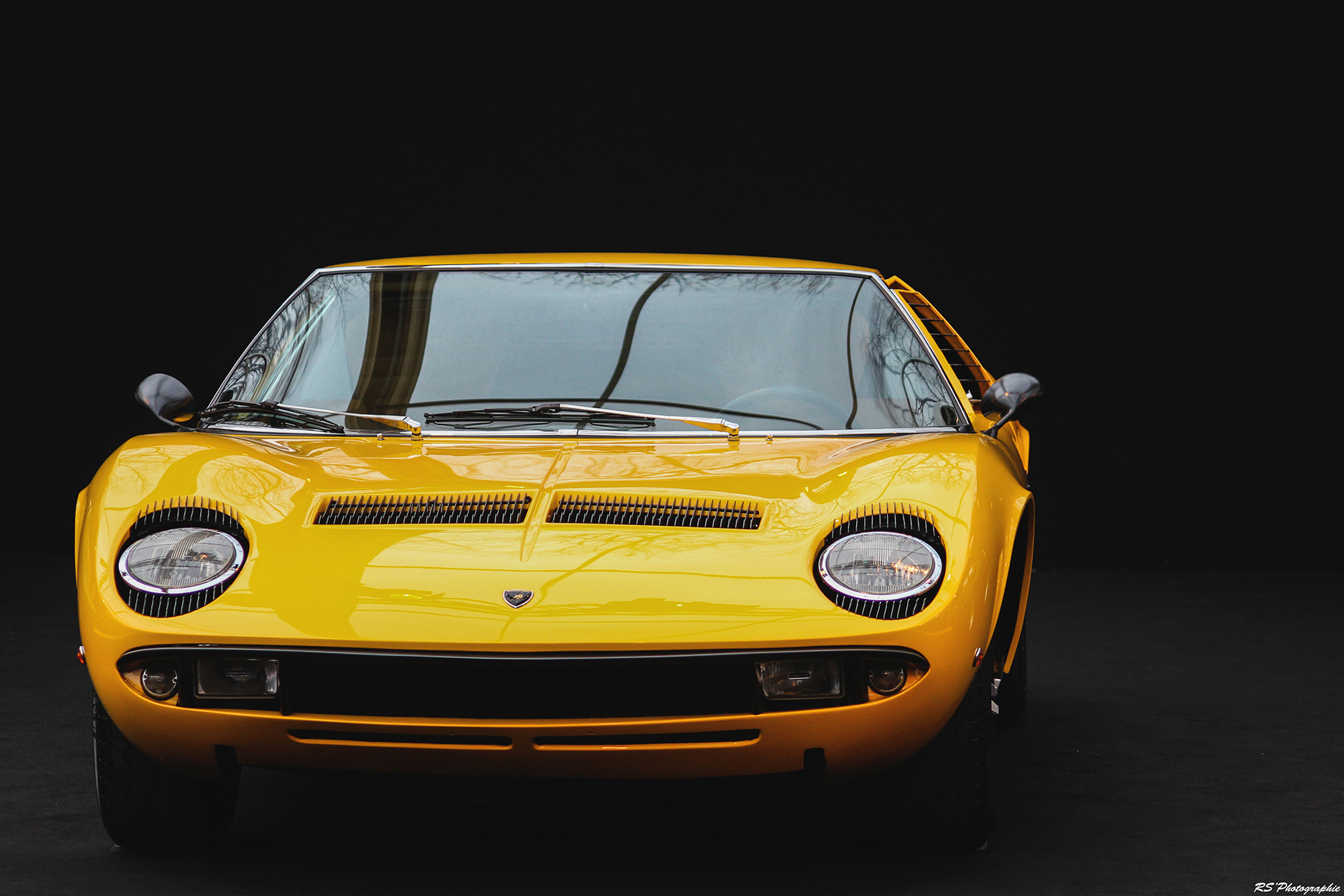
Lamborghini Miura – Exposition Concept cars 2016 – Arnaud Demasier RS Photographie
English summary
A story of Automobili Lamborghini: 1966 P400 Miura
The Miura’s rolling chassis was presented at the 1965 Turin auto show, and the prototype P400 debuted at the 1966 Geneva show, to stellar receptions from showgoers and motoring press alike. Both were impressed by Marcello Gandini’s sleek styling and the car’s revolutionary mid-engine design. In 1965, Wallace worked with Gianpaolo Dallara and Dallara’s then-assistant Paolo Stanzani to develop a prototype car at Lamborghini.
During 1965, Lamborghini’s three top engineers, Gian Paolo Dallara, Paolo Stanzani, and Bob Wallace put their own time into developing a prototype car known as the P400. The engineers envisioned a road car with racing pedigree – one which could win on the track and be driven on the road by enthusiasts. The three men worked on its design at night, hoping to convince Lamborghini such a vehicle would neither be too expensive nor distract from the company’s focus.
The car featured a transversely-mounted mid-engine layout, a departure from previous Lamborghini cars. The V12 was also unusual in that it was effectively merged with the transmission and differential, reflecting a lack of space in the tightly-wrapped design. The rolling chassis was displayed at the Turin Salon in 1965. Impressed showgoers placed orders for the car despite the lack of a body to go over the chassis.
Bertone was placed in charge of styling the prototype, which was finished just days before its debut at the 1966 Geneva motor show. Curiously, none of the engineers had found time to check if the engine fit inside its compartment. Sales head Sgarzi was forced to turn away members of the motoring press who wanted to see the P400’s power plant. Despite this setback, the car was the highlight of the show, immediately boosting stylist Marcello Gandini’s reputation.
Early Miuras, known as P400s (for Posteriore 4 litri), were powered by a version of the 3.9 L Lamborghini V12 engine used in the 400GT at the time, only mounted transversely and producing 350 hp. Lamborghini formed the engine and gearbox in one casting.
All cars had steel frames and doors, with aluminum front and rear skinned body sections. When leaving the factory they were originally fitted with Pirelli Cinturato 205VR15 tyres (CN72).
Debuting in 1966, the mid-mounted transverse V-12-powered Miura elevated the standard of performance lunacy while simultaneously coining the term supercar. Trendsetting designs rarely go hand-in-hand with benchmark performance figures, but the Miura managed to accomplish both, launching Lamborghini in the big leagues seemingly overnight.
Work to ready the Miura immediately proceeded at a feverish pace. Gandini later recounted that from October to February, everyone worked around the clock, seven days a week, like madmen. A major event was coming up and no one wanted to miss the opportunity to present this now model: the 1966 Geneva Motor Show. And therein lay the miracle: that the chassis presented as a completely experimental prototype in the autumn of 1965 had become the most stunning road car in the world – in just four months. The Miura reigned supreme at the Motor Show in Geneva.
Enthusiasm was sky-high and, in a sensational coup, Lamborghini managed to raise it even higher by bringing the Miura to the Monte Carlo Grand Prix, the most exciting weekend for sports cars in general and for top-level Italian ones in particular. The orange Miura he parked in front of the Hotel de Paris that Saturday afternoon attract so many oglers that they completely jammed the square in front of the Casino, arousing even more enthusiasm, interest and orders. It was, quite simply, a runaway success.
1967 Lamborghini Miura P400 – Jay Leno’s Garage 2012
1967 Lamborghini Miura P400. The first supercar from the House of the Raging Bull.
MAJ 13/03/2016
Lamborghini Miura SV de 1971 restaurée en 2016
Lamborghini vient d’achever la restauration d’un prototype de Miura SV. Ce modèle est un véhicule de pré-production qui a été exposé au salon de Genève en 1971. Ce modèle, de son numéro de châssis #4846, fait partie des premiers de Miura SV.
Il s’agit d’un prototype de pré-production mis en avant à diverses reprises et notamment au salon de Genève en 1971. La restauration comprend le remplacement de certaines pièces et le renouvellement de la couche de peinture avec une teinte Verde Metallizata.
« Cette voiture est très importante pour nous, non pas seulement pour sa place dans l’histoire de la marque comme étant le show car présenté à Genève préfigurant la future Miura SV, comme étant le premier projet complet de Lamborghini Polo Storico » explique Enrico Maffeo, en charge de ce département. « Nous sommes ravis de pouvoir, avec l’accord du propriétaire, présenter cette voiture pour la première fois entièrement restaurée à l’événement d’Amelia Island ».
Pour rappel, le département Lamborghini Polo Storico a vu le jour au printemps 2015. Il propose une expertise historique dans 4 domaines : la restauration de Lamborghini anciennes, l’archivage, des pièces d’origine de rechange et la certification des modèles historiques.
Lamborghini a souhaité rendre à sa supercar sa première jeunesse tout en la conservant la plus proche possible de ce qu’elle était lorsqu’elle s’est laissée découvrir pour la première fois. Les passionnés pourront l’admirer en vrai au prochain Amelia Island Concours d’Elegance qui a lieu le weekend du 12 mars 2016.
Lamborghini Polostorico Celebrates Miura 50 Anniversary at Amelia Island with restored Miura SV 1971 Geneva Show Car
Sant’Agata Bolognese, 11 March 2016 – The original Lamborghini Miura SV shown at Geneva motor show in 1971 has been the subject of more than a year’s restoration by Lamborghini PoloStorico, and is presented as a finished project at the Amelia Island concours event (USA) from 10 to 13 March.
The Lamborghini Miura SV (Super Veloce), chassis #4846, was the pre-production model for subsequent Miura SV production. Unveiled at the 1971 Geneva motor show on Bertone’s stand (while Lamborghini showed its new Countach), the car was truly a one-off, carrying over parts from the previous Miura S and introducing new features that would be seen on later SVs.
Lamborghini PoloStorico was appointed a year ago to fully restore chassis #4846 to its perfect original state. The subject of exhaustive research, each detail of the Geneva show car has been respected rather than adopting later production SV parts.
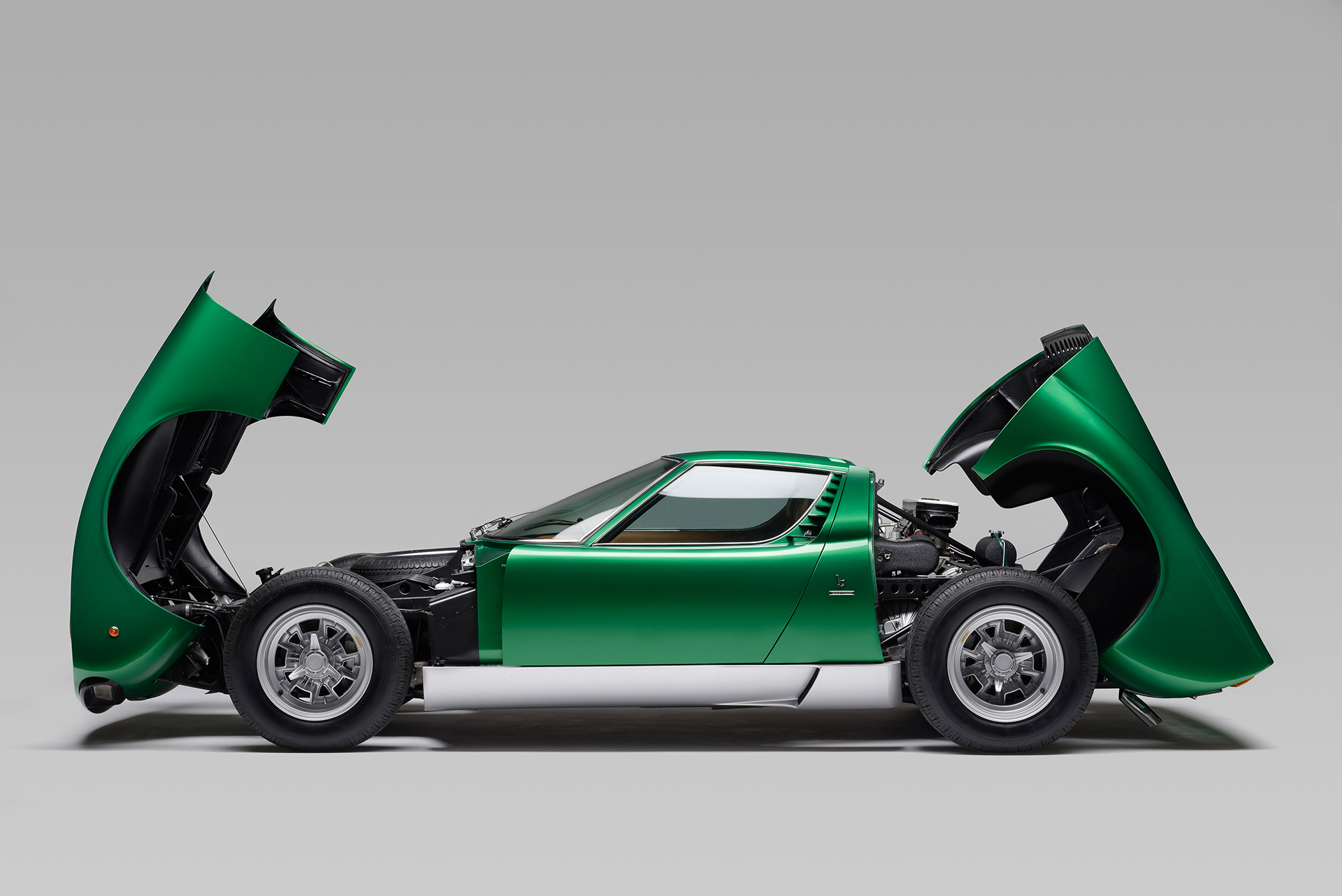
Lamborghini Miura SV 1971- 50 anniversario – Profilo Aperta – 2016
Shown in metallic green Verde Metallizata with tan leather, the restoration of #4846 by PoloStorico has included a complete restrip of the chassis and engine. Using photos and other archived historic documentation, every panel on the Miura has been returned to its original lines and angles and, following the original production sheet and records held by Automobili Lamborghini, every component restored or replaced. Expert Lamborghini craftsmanship and original Lamborghini parts have been used throughout, from bodywork to repainting the car in its original color, refurbishing the interior and overhauling the engine.
“This is a very important car, not only for its place in history as the Geneva show car and the forerunner of future Miura SV models built, but as the first completed project of Lamborghini PoloStorico. We are delighted to be able, with the consent of the owner, to show this car for the first time in its perfectly restored state, at the important Amelia Island event.
“This is the year in which the Lamborghini Miura celebrates its fiftieth anniversary. This car not only illustrates the iconic appeal of the Miura, widely acknowledged as the forerunner of modern super sports models, but is also a perfect example of the expertise available in Lamborghini PoloStorico in providing the most authentic Lamborghini restorations.”
- Enrico Maffeo, Head of PoloStorico
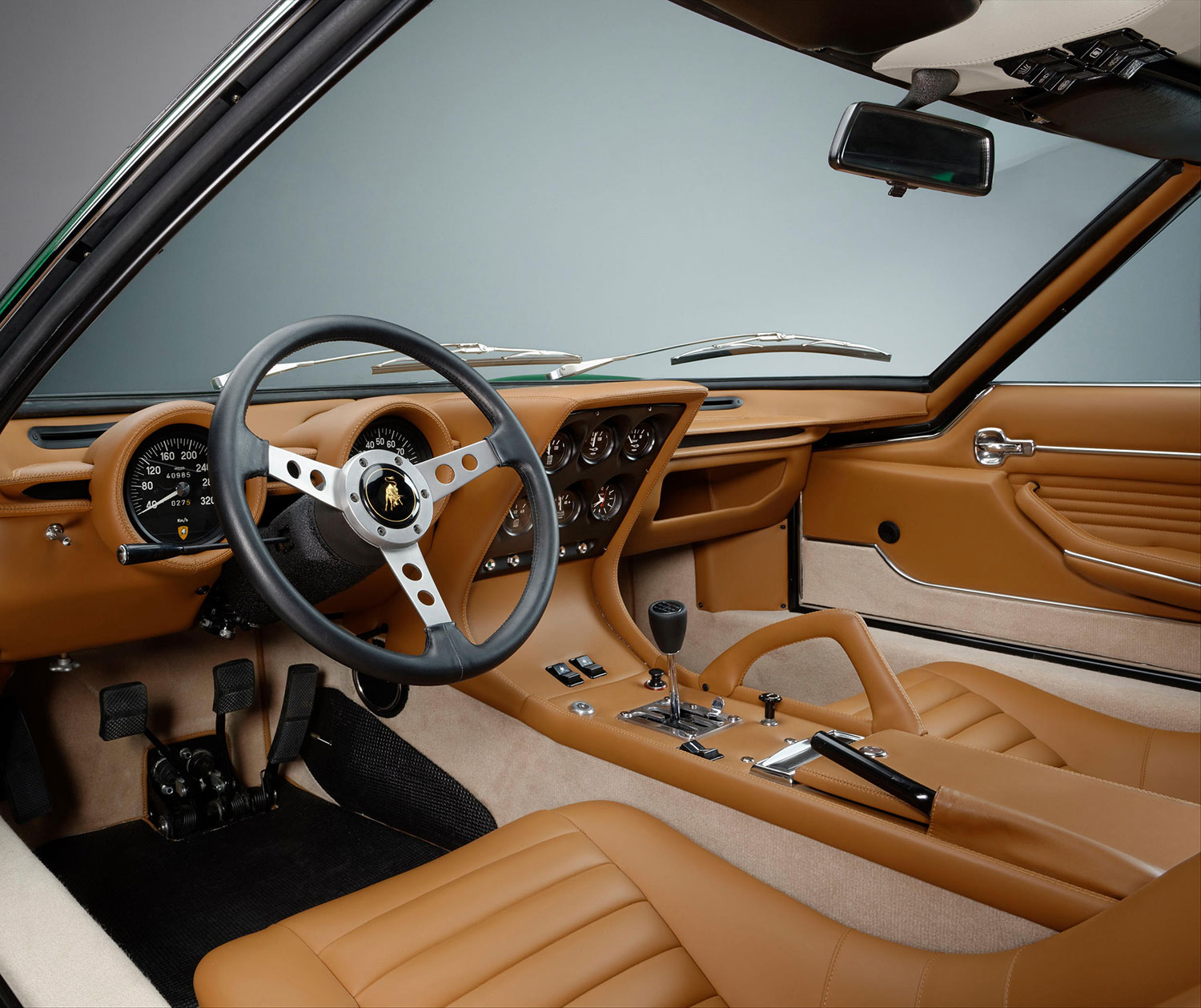
Lamborghini Miura SV 1971- 50 anniversario – interior – 2016
Lamborghini PoloStorico officially opened in spring 2015, supporting historic models and Lamborghini’s heritage through four main areas: restoration of historic Lamborghini models; archive management; original Lamborghini spare parts for which around 70% of the historic car parc is covered; and official certification of Lamborghini historic cars.
Source et images :
Lamborghini
Partager la publication "Lamborghini Miura : première supercar au moteur Posteriore 4 litri. V12. 350 ch. Genève 1966"

